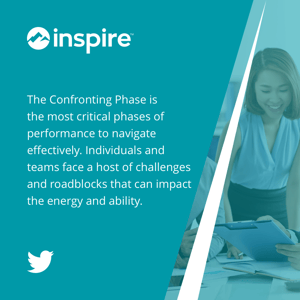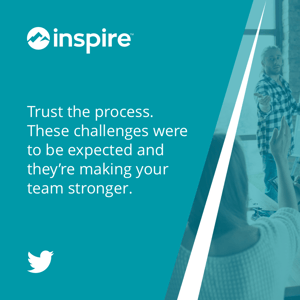“Life is Difficult.” proclaimed best selling author, Scott Peck, in the opening line of his book, The Road Less Traveled. This concise statement, sums up the great journey of life, with simplicity and truth. In fact, any worthy journey is filled with setbacks, challenges, questions and doubts — particularly if you have a specific destination in mind. The great opportunity we have in this human experience is to confront these challenges with an authentic investigation of our ability to press on toward the prize, and our energy to continue on in the pursuit of our desired destination.
Why do we expect it to be any different at work? Work is difficult. It should be challenging and sometimes confusing, or even overwhelming at times. If it’s not, then perhaps you’re not pushing yourself or your team members to pursue a higher level of excellence in service to your internal or external customers.
Phases of Performance
Decades of research in adult learning theory and motivational science reveals a common pattern of levels, or phases, individuals, teams, and organizations go through in pursuit of their goals and strategy. The authors of Leadership Genius, a comprehensive, researched-based leadership curriculum, have identified 5 Phases of Performance every employee, team, or organization goes through in the pursuit of a goal or business strategy. There are two key indicators of an employee, team, or organization’s Phase of Performance toward an objective — their Ability to achieve the goal and the Energy they are experiencing toward the pursuit of the goal.
Fight low energy and improve #performance in the #ConfrontingPhase by understanding your unique challenges and learning on the go from @InspireSoftware:Tweet This!The Confronting Phase of Performance
Inevitably, the pursuit of goals will encounter a phase that challenges our knowledge and skills as well as test our motivations to pursue any objective we are attempting to achieve. The authors of Achieve Leadership Genius call this the Confronting Phase of Performance.
“In the Confronting Phase of Performance,” says co-author Dr. Drea Zigarmi, “your ability to achieve this specific goal may have only slightly increased, but your energy level naturally drops because you are experiencing challenges, setbacks, or uncertainty about the objective you’re trying to pursue.”
Confronting the Challenge
As leaders, it’s important to actively engage lower levels of ability and energy toward a goal as a natural part of the performance process. The important thing for you as a leader, in any context, is to recognize and communicate performance needs through effective conversations, especially during this challenging phase.
Individuals, Teams, and Organizations can struggle with their lower skills or knowledge toward the specific objective they are pursuing, as well as begin to experience lower levels of energy and motivation toward the goal. Even if your team or organization has achieved success on a similar goal in the past, it is inevitable that everyone, by nature, will go through the Confronting Phase of Performance when they are committed to pursuing a new goal. How you respond as a leader is critical to effectively guide yourself and others through this phase.
Failing Forward in the Confronting Phase
 The Confronting Phase is one of the most critical phases to tactfully navigate as a leader in any context. It is a fragile phase for individuals, teams, or organizations pursuing their objectives, but it is ripe with lessons to be learned about the client, the business problems you’re trying to solve, the shifting details of the end objective you’re trying to pursue, and opportunities to grow and work through challenging conversations with team members. Teams face a slew of challenges and roadblocks eroding much of the high energy they experienced during the Curious Phase of Performance when they first began the pursuit of the goal. This decline in energy can be lethal to any performance objective is not properly recognized and engaged.
The Confronting Phase is one of the most critical phases to tactfully navigate as a leader in any context. It is a fragile phase for individuals, teams, or organizations pursuing their objectives, but it is ripe with lessons to be learned about the client, the business problems you’re trying to solve, the shifting details of the end objective you’re trying to pursue, and opportunities to grow and work through challenging conversations with team members. Teams face a slew of challenges and roadblocks eroding much of the high energy they experienced during the Curious Phase of Performance when they first began the pursuit of the goal. This decline in energy can be lethal to any performance objective is not properly recognized and engaged.
A team’s ability is also lower during this phase and an efficient workflow hasn’t been achieved yet because they may need to revisit skills they’ve used to solve similar problems in the past or learn new skills to address some of the problems they’ve experienced since setting the goal. One of the biggest mistakes that individuals and teams make during the pursuit of goals is assuming that skills they’ve used on similar goals in the past will directly apply to this goal. Every goal is unique, even if you’ve mastered the skills needed to make progress on this goal. Rushing through the confronting phase of performance because of confidence in your skills may blind you to the unique needs of the goal you are currently pursuing. Slow down, and make sure that your skills are meeting the needs of this specific goal, not goals you’ve achieved in the past.
What You’re Up Against
There are several factors that make the Confronting Phase arduous. Here are just a few and your responsibility as a leader when you encounter them:
The Honesty Factor
Toxic work cultures that place an extremely high value on competence make it difficult for employees to learn new skills by asking for help. Because of this, managers often assume since employees aren’t asking for help they have the necessary skills and knowledge to achieve the goal. They may also assume the energy level is still high toward achieving the goal since they haven’t heard any questions or concerns about the pursuit of the goal due to fear of being seen as uncommitted to the objective. In reality, employees are simply too afraid to ask for help in building the necessary skills or motivation to keep moving forward effectively in their performance.
Leadership to dos: Make your organization a place that embraces learning and collaboration by prioritizing it at all levels. Make failing safe for employees. While you don’t have to celebrate failures, you should recognize the key learnings from making mistakes during the Confronting Phase of Performance. Encourage risk-taking and innovation in the name of learning, then approach your performance objectives from a more realistic viewpoint. If you don’t encourage honesty about your current reality, especially when you’re in the early learning phases of a goal, then you won’t effectively move forward.
Look at your team’s #challenges as an #opportunity to improve, not an annoyance. @InspireSoftware Tweet this!Clashing Perceptions
Through ongoing conversations about performance, and what you are learning during this phase, you may discover your team doesn’t share the same perception of your ability and energy toward the pursuit of the goal. For example, the team may feel their ability is high, but after assessing the scope of challenges during this stage, you may discover they need additional training to achieve the goal in the time desired.
Leadership to dos: Communication is key during every phase of performance, but it is never more critical than during the Confronting Phase. Be open and honest about you or your team’s ability to achieve the specific objective you agreed to pursue. Check in regularly and provide detailed feedback at least once a week during this phase to ensure these differing perceptions don’t hinder your progress.
Big Goal Syndrome
Large goals with many moving parts can be troublesome to assess. It’s possible different components of your goal are experiencing different phases because it’s too big or not specific enough. If you realize you’re pursuing more than one objective at a time, the goal should be broken up into smaller, more achievable goals and evaluated individually to address progress more effectively than a large and complex goal. Failure to do so could make your assessments of progress inaccurate and could negatively impact individual and team engagement.
Leadership to dos: As a leader, it’s your responsibility to recognize when goals become too large. You should meet with your team to break down the large or unspecific goal into smaller more attainable goals. After doing so you should decide how your team will evaluate each smaller goal.
Outside Influences
 The amount of traffic on your employees’ morning commute could affect their energy levels or even an event that happened the night before. There are many factors affecting self-confidence or a person’s motivational outlook, thus affecting their energy on any given day. Some of those things are out of your control, but if emotional factors are diminishing because of uncertainty around the actual goal itself, the reasons for their suboptimal motivation should be discussed during a performance check-in conversation with the employee or team.
The amount of traffic on your employees’ morning commute could affect their energy levels or even an event that happened the night before. There are many factors affecting self-confidence or a person’s motivational outlook, thus affecting their energy on any given day. Some of those things are out of your control, but if emotional factors are diminishing because of uncertainty around the actual goal itself, the reasons for their suboptimal motivation should be discussed during a performance check-in conversation with the employee or team.
Leadership to dos: You should keep these performance check-ins brief and focused on work as much as possible. Don’t force your employee to share personal information with you if they aren’t forthcoming. Personal conversations with your employees can be awkward, but can also be rewarding. These conversations also signal to your employees that you care about them outside of their work life.
When the excitement experienced during the Curious Phase is gone and the team is not feeling as highly motivated as they were when they began working toward the goal, don’t despair or panic. Instead, embrace it and grow through it. With low energy and ability, a goal can seem unattainable or too time-consuming for leaders to cultivate effective conversations around the challenges of the goal. Individuals and teams can quickly become moderately or even actively disengaged during the confronting phase. As a leader, it's your responsibility to remind the team of the importance and necessity of achieving the goal and have authentic and meaningful conversations about their ability and energy toward the goal. It's imperative you maintain a positive outlook and continue to communicate with your team. Continue to be honest with your team; don’t sugarcoat issues, but approach them with a level head and a can-do attitude.
To learn how to better combat issues you may face during this phase, check out these leadership tactics to guarantee success.

